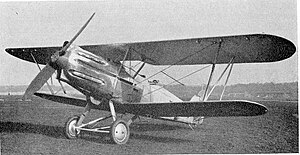Hawker Hector
| Hector | |
|---|---|

| |
| Role | Army co-operation |
| Manufacturer | Hawker Aircraft |
| First flight | 14 February 1936 |
| Status | retired |
| Primary users | Royal Air Force Irish Air Corps |
| Number built | 179 (including 1 prototype)[1] |
| Developed from | Hawker Hart |
TheHawker Hectorwas a Britishbiplanearmy co-operationandliaison aircraftof the late 1930s; it served with theRoyal Air Forceand saw brief combat in theBattle of Francein May 1940. Some Hectors were later sold toIreland.It was named after the Trojan princeHector.
Design and development
[edit]The Hector was intended as a replacement for theHawker Audaxarmy co-operation aircraft. The design and the building of the prototype was done by Hawker but production aircraft were built byWestland AircraftinYeovil,Somerset. Because of the demand forRolls-Royce Kestrelengines required for theHawker Hindprogramme, an alternative power plant was specified. Consequently, the 24 cylinder 805 hp (600 kW)Napier DaggerIII was used. The prototype first flew on 14 February 1936 withGeorge Bulmanas pilot. One prototype and 178 production aircraft were built.
Operational service
[edit]Starting in February 1937, the Hector began equipping the sevenRAFarmy co-operation squadrons that would use it, but it in turn began to be replaced byWestland Lysandersbeginning in July 1938.[2]The Hectors were transferred toAuxiliary Air Forcesquadrons.613 Squadronwas converting to Lysanders atRAF Hawkingeand flew in support of the Allied garrison in theSiege of Calais.[3]On 26 May, along with its Lysanders, six Hectors dive bombed German positions around Calais and on the following day, tried to drop supplies to the troops, unaware that they had already surrendered; two Hectors were lost.[3]Hectors were used by the RAF from 1940 astarget-tugs,and for towingGeneral Aircraft Hotspurtraining gliders.
TheIrish Air Corpsreceived 13 examples after theDunkirk Evacuationin 1941–42 and in general were in poor condition. They were sold by the BritishWar Officeto Ireland upon requests for aircraft as the Irish military found themselves wholly unprepared for modern warfare but still relied almost completely onBritainfor military supplies. The defence of Ireland was in the British interest but while they were fighting theBattle of Britain,they could not afford to sell the Irish Government anything better than the Hector. The type was deeply unpopular with ground crews due to the complicated and unreliable Dagger engine, whose tightly packed high revving 24 cylinders made access difficult.
Variants
[edit]- Hector Mk I:Two-seat army co-operation aircraft for the RAF.
Operators
[edit]Specifications (Hector)
[edit]Data fromHawker Aircraft since 1920[5]
General characteristics
- Crew:Two
- Length:29 ft9+3⁄4in (9.09 m)
- Upper wingspan:36 ft11+1⁄2in (11.26 m)
- Lower wingspan:31 ft 4 in (9.55 m)
- Height:10 ft 5 in (3.18 m)
- Wing area:346 sq ft (32.1 m2)[6]
- Empty weight:3,389 lb (1,537 kg)
- Gross weight:4,910 lb (2,227 kg)
- Powerplant:1 ×Napier DaggerIII 24-cylinder air-cooledH-block engine,805 hp (600 kW)
- Propellers:2-bladed fixed pitch wooden propeller
Performance
- Maximum speed:187 mph (301 km/h, 162 kn) at 6,600 ft (2,000 m)
- Stall speed:50 mph (80 km/h, 44 kn)[7]
- Range:300 mi (480 km, 261 nmi)[6]
- Service ceiling:24,000 ft (7,300 m)
- Time to altitude:5 minutes 40 seconds to 10,000 ft (3,000 m)
Armament
- Guns:** 1 × forward-firing.303 in (7.7 mm)Vickers machine gunMk.V
- 1 ×.303 in (7.7 mm)Lewis gunin the rear cockpit on a Hawker mount
- Bombs:Mountings for a camera, flares, and 2 × 112 lb (51 kg) bombs (or containers)
Surviving aircraft
[edit]In 1996, an ex-Irish Air Corps Hector88(ex RAFK8130) was recovered for eventual restoration from nearDundrumin Ireland.[8]
Parts of HectorK8096remain onRed Pikein the English Lake District. The aircraft crashed on 8 September 1941, killing its pilot.[9]
See also
[edit]Related development
Aircraft of comparable role, configuration, and era
Related lists
References
[edit]Citations
[edit]- ^"Hawker Hector".BAE Systems.Retrieved1 August2023.
- ^Jackson, 2006, p.61
- ^abThetford, 1962, p.304
- ^Halley 1980, p. 352.
- ^Mason 1991, p.265–266.
- ^abMason 1994, p.281
- ^ATA Ferry Pilots Notes 1996
- ^Simpson, 2013
- ^"Hector K8096 on Red Pike, Wasdale".Aircraft accidents in the English Lake District.Yorkshire Aircraft. Archived fromthe originalon 29 May 2011.Retrieved7 August2015.
Bibliography
[edit]- Air Transport Auxiliary Ferry Pilots Notes (reproduction).Elvington, York, UK: Yorkshire Air Museum, 1996.ISBN0-9512379-8-5.
- Crawford, Alex.Hawker Hart Family.Redbourn, Hertfordshire, UK: Mushroom Model Publications Ltd., 2008.ISBN83-89450-62-3.
- Halley, James J.The Squadrons of the Royal Air Force.Tonbridge, Kent, UK: Air Britain (Historians), 1980.ISBN0-85130-083-9.
- Jackson, Robert (2006).Army Wings: A History of Army Air Observation Flying 1914–1960.Pen & Sword Books. p. 61.ISBN978-1-84415-380-0.
- Mason, Francis K.Hawker Aircraft since 1920.London: Putnam, 1961 (Third revised Edition 1991).ISBN0-85177-839-9.
- Mason, Francis K.The British Bomber since 1914.London: Putnam. 1994.ISBN0-85177-861-5.
- Simpson, Andrew (2013)."A/C Serial No. BAPC82 Section 2B Individual History Hawker Hind (Afghan) BAPC 82 Museum Accession No.69/A/104"(PDF).Royal Air Force Museum.Retrieved7 August2015.
- Thetford, Owen Gordon (1962).Aircraft of the Royal Air Force since 1918.Putnam. p. 304.OCLC816338199.
